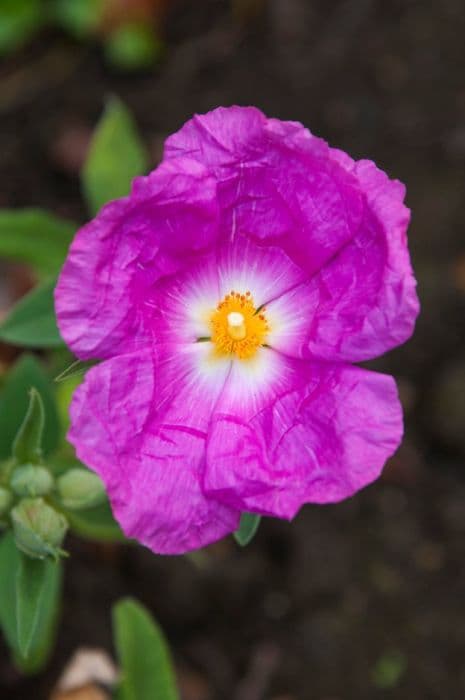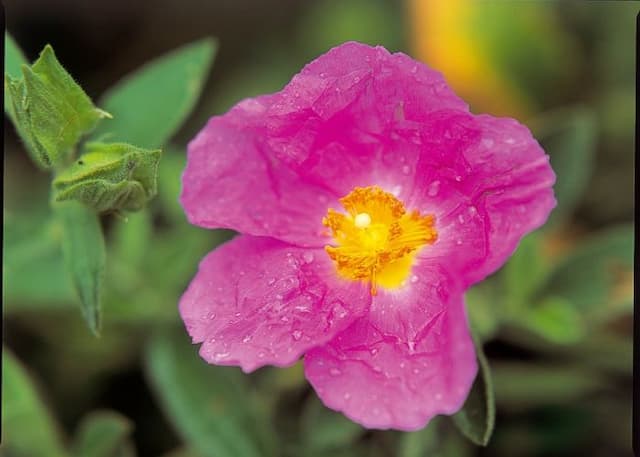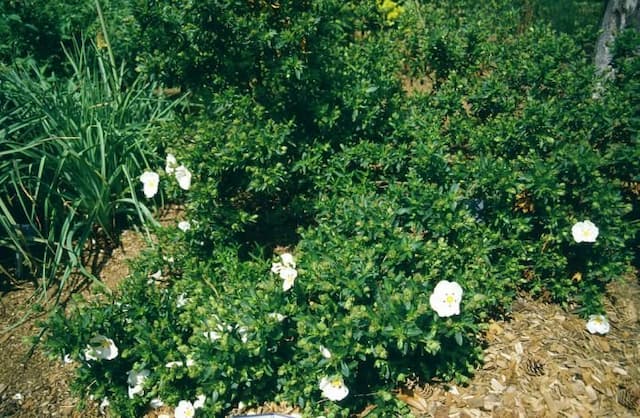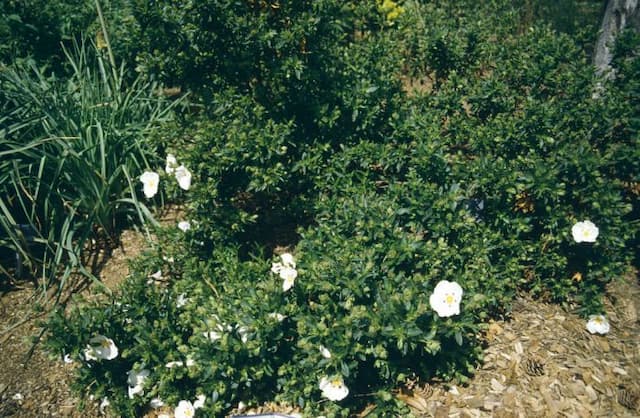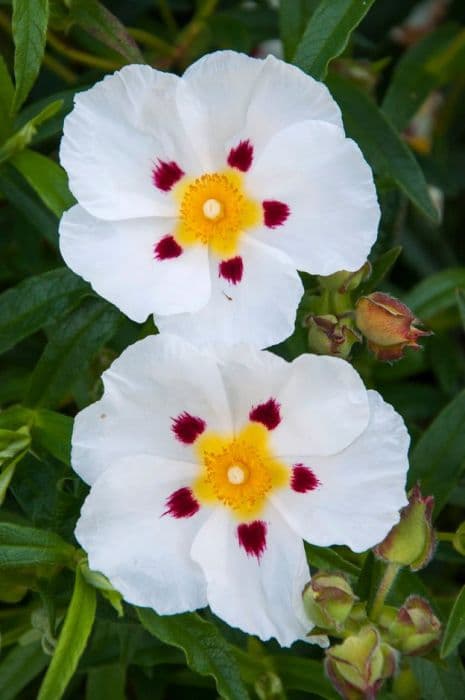Rock Rose Cistus × laxus 'Snow White'

ABOUT
The plant known as 'Snow White', is a delightful evergreen shrub that boasts an abundance of pure white flowers. These flowers are notably large and saucer-shaped, with a radiant display that can brighten any garden. The blossoms have a papery texture and are comprised of five delicate petals each, often showcasing a subtle hint of yellow at their center, where a cluster of stamens lies. This adds a pleasant contrast to the plant's overall appearance. 'Snow White' has a lush, dense foliage that provides a backdrop to its snow-white blossoms. The leaves are a deep green color, which further accentuates the purity of the flowers. They are arranged alternately along the stems and have a slightly sticky texture when touched. The plant's foliage remains throughout the year, ensuring that the garden remains vibrant even when the plant is not in bloom. This particular cultivar is a part of a group of plants which are known for their resilience and ability to thrive in tough conditions. It forms a rounded and bushy habit, presenting a neat and compact appearance that makes it an attractive choice for gardeners seeking to add a touch of elegance to their outdoor spaces. The 'Snow White' variant, with its striking white flowers and robust greenery, is a splendid option for adding a long-lasting splash of color to any landscape. It is often used in borders, rock gardens, or as a focal point among other garden plants, where it can captivate onlookers with its simplistic yet eye-catching beauty.
About this plant
 Names
NamesFamily
Cistaceae
Synonyms
Snow White Cistus, Snow White Rockrose
Common names
Cistus × laxus 'Snow White'.
 Toxicity
ToxicityTo humans
The rockrose (Cistus × laxus 'Snow White') is not widely documented as a toxic plant to humans. No significant toxic effects have been associated with this plant, and it is generally considered safe around people. Ingesting any part of the plant is unlikely to cause severe symptoms of poisoning.
To pets
The rockrose (Cistus × laxus 'Snow White') is also not known to be toxic to pets. It is not typically listed among plants that pose a risk to pets such as cats and dogs, and there are no substantial reports of toxicity from ingestion. Therefore, it is generally considered safe for pets as well, with no expected serious consequences following consumption.
 Characteristics
CharacteristicsLife cycle
Perennials
Foliage type
Evergreen
Color of leaves
Green
Flower color
White
Height
5 feet (1.52 meters)
Spread
5 feet (1.52 meters)
Plant type
Shrub
Hardiness zones
8
Native area
Mediterranean
Benefits
 General Benefits
General Benefits- Ornamental Appeal: The Cistus × laxus 'Snow White', commonly known as Rock Rose, features attractive white flowers that enhance the aesthetic value of gardens and landscapes.
- Drought Tolerance: Rock Rose is known for its ability to withstand dry conditions once established, reducing the need for frequent watering.
- Low Maintenance: This plant requires minimal care, making it suitable for gardeners with limited time or those new to gardening.
- Rapid Growth: Rock Rose has a fast growth rate, ensuring quick coverage and filling in garden spaces effectively.
- Sun Loving: It thrives in sunny locations, making it an excellent choice for sunny borders and open areas.
- Pest Resistance: The plant is generally resistant to pests, minimizing the need for chemical treatments.
- Attracts Pollinators: With its flowers, Rock Rose attracts beneficial pollinators like bees and butterflies to the garden.
- Evergreen: Being evergreen, it provides year-round interest and structure to the garden landscape.
- Soil Adaptability: Rock Rose can adapt to a variety of soil types, although it prefers well-drained soils.
- Erosion Control: Its root system helps stabilize slopes and can be used for erosion control in challenging areas.
- Frost Tolerance: It can tolerate low temperatures and is resistant to frost damage, making it suitable for various climate zones.
- Wildlife Shelter: The dense foliage offers shelter to small wildlife, contributing to biodiversity.
 Medical Properties
Medical PropertiesThis plant is not used for medical purposes.
 Air-purifying Qualities
Air-purifying QualitiesThis plant is not specifically known for air purifying qualities.
 Other Uses
Other Uses- Crafting Perfume: Rockrose 'Snow White' essential oil can be extracted and used in perfumery for its sweet, amber-like fragrance.
- Dye Production: The plant can be used to produce a natural dye for textiles, which offers shades of tan or purple depending on the mordant used.
- Floral Arrangements: Fresh or dried Rockrose 'Snow White' flowers can be used in floral arrangements, adding a touch of elegance with their simple white blooms.
- Bonsai Artistry: Due to its attractive form and foliage, this plant can be trained as a bonsai, providing a Mediterranean touch to the art form.
- Landscape Photography: Rockrose 'Snow White''s picturesque blossoms provide an exemplary subject for landscape and nature photographers.
- Themed Gardens: It can be included in fairy-tale or white-themed gardens for harmonious color coordination and thematic landscaping.
- Educational Resource: This plant can be used for educational purposes, demonstrating pollination and plant growth to students and gardening enthusiasts.
- Erosion Control: Rockrose 'Snow White' can be planted on slopes or areas prone to erosion to help stabilize the soil with their root systems.
- Wildlife Habitat: The dense foliage provides excellent cover for small animals and beneficial insects, enhancing biodiversity in the garden.
- Culinary Garnish: Although not commonly used for culinary purposes, the flowers can be used as an edible garnish to add visual appeal to dishes.
Interesting Facts
 Feng Shui
Feng ShuiThe Rockrose is not used in Feng Shui practice.
 Zodiac Sign Compitability
Zodiac Sign CompitabilityThe Rockrose is not used in astrology practice.
 Plant Symbolism
Plant Symbolism- Purity: The 'Snow White' name and the white color of the Cistus × laxus flowers symbolize purity and innocence, reminiscent of untouched snow.
- Resilience: Cistus plants are known for their hardiness and ability to withstand tough conditions, symbolizing resilience and the ability to endure challenges.
- Healing: In herbal medicine, Cistus is often associated with healing properties, symbolizing recovery and the restoration of health.
- Beauty: The delicate and ornamental flowers of the 'Snow White' plant symbolize beauty, grace, and appreciation for the aesthetic.
- Transience: Cistus flowers have a brief lifespan, which can symbolize the ephemeral nature of life and the beauty of fleeting moments.
 Water
WaterRockrose 'Snow White' prefers well-draining soil and does not require frequent watering. Water the plant deeply but infrequently, allowing the soil to dry out between waterings. Typically, watering once every 7 to 10 days will be sufficient, but this can vary based on climate and soil conditions. During the hot summer months, you might need to water more frequently, while in cooler weather, you can reduce the frequency. When you do water, aim for about 1 gallon of water to ensure it reaches deep into the root zone.
 Light
LightRockrose 'Snow White' thrives in full sunlight. It should be planted in a spot where it can receive at least 6 to 8 hours of direct sunlight daily. Avoid planting in full shade as this will inhibit its growth and flowering capability; partial shade is acceptable as long as most of the day is spent in bright conditions.
 Temperature
TemperatureRockrose 'Snow White' prefers a temperate climate and can tolerate a range of temperatures, typically doing well in zones 8 to 11. It can withstand a minimum temperature of around 10°F for short periods, but frost may damage the plant. The ideal temperature range for this plant is between 50°F and 80°F. It is heat-tolerant and can endure high summer temperatures.
 Pruning
PruningPruning Rockrose 'Snow White' helps to maintain its shape and promotes more vigorous growth. It is best to prune in early spring before new growth begins, cutting back the previous year's growth by about one-third. You can also remove any dead or damaged branches as needed to keep the plant healthy. Pruning should be done annually for best results.
 Cleaning
CleaningAs needed
 Soil
SoilRockrose 'Snow White' thrives in well-draining soil with gritty or sandy texture. The best soil mix includes equal parts potting soil, coarse sand, and peat or compost. Maintain soil pH between 6.0 and 8.0 for optimal growth.
 Repotting
RepottingRockrose 'Snow White' should be repotted every 2-3 years to refresh the soil and accommodate root growth. The plant prefers not to be disturbed frequently, so repotting should be done with care.
 Humidity & Misting
Humidity & MistingRockrose 'Snow White' is adaptable to various humidity levels but prefers a moderate to dry environment. It thrives in typical outdoor humidity conditions without needing special attention to humidity levels indoors.
 Suitable locations
Suitable locationsIndoor
Place Rockrose 'Snow White' in bright light, minimal water, no excess humidity.
Outdoor
Plant Rockrose 'Snow White' in full sun, shelter from extreme cold.
Hardiness zone
Rockrose 'Snow White' is suitable for 8-11 USDA hardiness zones.
 Life cycle
Life cycleThe Rockrose 'Snow White' begins its life cycle with seed germination, typically in a warm and well-drained environment. Once sprouted, the seedling develops into a young plant with characteristic woody stems and dark green leaves. Over time, as the plant matures, it reaches the flowering stage, producing showy white flowers with a distinctive yellow center, usually in spring or early summer. After pollination, often by bees or other insects, the flowers develop into seed capsules, which, when dried, release seeds for the next generation. The Rockrose 'Snow White' is a perennial plant, which means it can live for several years, going through repeated cycles of growth, flowering, and seed production. As a hardy shrub, it reaches full maturity within a few years, after which it can withstand drought and poor soil conditions, continuing its life cycle until environmental stress or disease eventually leads to the plant's decline and death.
 Propogation
PropogationPropogation time
Spring-Early Summer
The Cistus × laxus 'Snow White', commonly known as the Snow White Rockrose, is typically propagated by semi-hardwood cuttings. The best time to take cuttings for propagation is in late summer. To propagate, a semi-hardwood cutting of about 4 to 6 inches (10 to 15 centimeters) long is taken from a healthy parent plant. The lower leaves are removed, and the cut end can be dipped in rooting hormone to encourage root growth. The cutting should then be planted in a well-draining soil and kept moist until roots have established, which usually takes several weeks. The new plants should be sheltered from direct sunlight and extreme temperatures to increase the success rate of rooting. It's important not to over-water the cuttings as this can cause rot.
